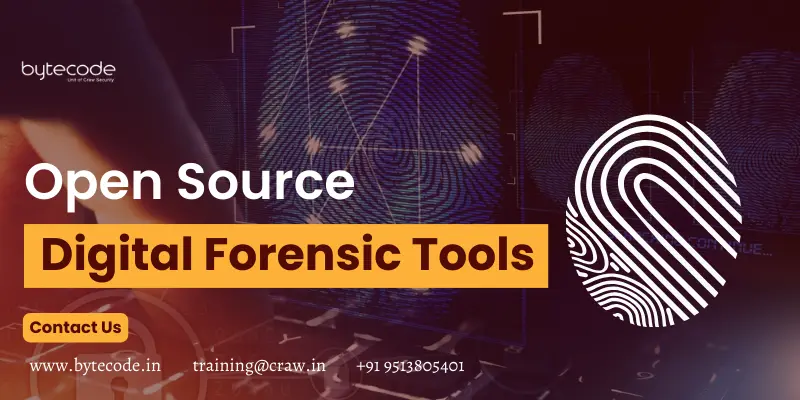Digital forensics is an essential aspect of cybersecurity, involving the recovery and investigation of material found in digital devices. With the increase in digital crimes, the importance of digital forensic tools has skyrocketed. In this blog, we’ll explore some of the most prominent open-source digital forensic tools and answer frequently asked questions in this field.
Essential Open Source Digital Forensic Tools
Wireshark
A network protocol analyzer that lets you capture and interactively browse the traffic running on a computer network.
Volatility
A memory forensics framework for incident response and malware analysis, which helps in the extraction of information from volatile memory (RAM),
The Sleuth Kit & Autopsy
The Sleuth Kit is a collection of command-line tools for forensic analysis. Autopsy is a graphical interface that uses The Sleuth Kit and other tools for efficient digital investigations.
Caine
A complete forensic environment that integrates several digital forensic tools. It’s user-friendly and comes with a graphical interface.
Nmap
A network discovery and security auditing tool. Nmap is used to discover devices running on a network and for security analysis.
Oxygen Forensic Suite
A comprehensive forensic application that allows an in-depth examination of mobile devices and cloud services.
SIFT (SANS Investigative Forensic Toolkit)
A collection of forensic tools is crucial for incident response and digital forensics.
CrowdResponse
A lightweight tool for gathering system information for incident response and security engagements.
Xplico
Designed to extract and analyze internet traffic, Xplico reconstructs the contents of acquisitions.
Digital Forensics Framework
An open-source tool that is less known but highly effective in managing digital investigations.
Dumpzilla
A tool to examine the contents of a browser’s configuration and stored data, like cookies and history.
Paladin
A robust tool for forensic imaging and analysis. Its strong point is its simplicity and ease of use.
ExifTool
A command-line application for reading, writing, and editing meta information in files.
FAW (Forensically Advanced Window)
Targets information floating on the web, gathering and analyzing web evidence.
Frhed
A binary file editor (hex editor) is primarily used for low-level data processing and analysis.
Magnet RAM Capture
A free imaging tool designed to capture the physical memory of a suspect’s computer.
MailXaminer
Specializes in the recovery, search, and analysis of emails, a critical component of many forensic investigations.
EnCase
A suite of digital investigations products by Guidance Software covers everything from acquisition to reporting.
NFI Defraser
A tool designed to detect full and partial multimedia files in data streams.
USB Write Blocker
It is essential for preventing write operations to USB devices during the forensic process.
ForensicUserInfo
Focuses on gathering user information from the operating system for analysis.
MVT (Mobile Verification Toolkit)
Used for analyzing mobile devices, specifically for security and privacy-focused investigations.
Angry IP Scanner
A lightweight network scanner is helpful for quickly scanning IP addresses and ports.
Frequently Asked Questions
- Q: Which is an open-source forensic tool?
A: Tools like Wireshark, The Sleuth Kit, Autopsy, and Volatility are some notable open-source forensic tools. - Q: What are the tools used in network forensics?
A: Network forensics commonly utilizes tools like Wireshark, Nmap, and Xplico for analyzing network traffic and activity. - Q: What is FTK used for?
A: FTK (Forensic Toolkit) is used for indexing, searching, analyzing, and managing digital evidence in a secure environment. - Q: Is Oxygen Forensic Suite open source?
A: No, Oxygen Forensic Suite is not open source; it is a proprietary tool. - Q: Can FTK image a phone?
A: Yes, FTK can be used to image and analyze data from mobile devices. - Q: How much does FTK cost?
A: The cost of FTK varies based on the licensing model and the specific needs of the organization. Contact the vendor for precise pricing. - Q: Why is FTK Imager used?
A: FTK Imager is used for imaging and data preview. It’s widely used due to its ability to create exact replicas of data without altering original evidence. - Q: What is FTK in cybersecurity?
A: In cybersecurity, FTK stands for Forensic Toolkit, a suite of tools for digital investigations and forensic analysis. - Q: Is Magnet Axiom free?
A: No, Magnet Axiom is a paid digital investigation tool. - Q: What are the two types of network forensics?
A: Network forensics can be broadly classified into two types: live forensics (analyzing live network traffic) and static forensics (investigating logs and past traffic). - Q: What are the two methods of network forensics?
A: The two primary methods in network forensics are catch-it-as-you-can and stop, look, and listen. - Q: What is forensics in networking?
A: Forensics in networking involves the monitoring and analysis of network traffic to identify unauthorized use, malware incidents, and other security breaches. - Q: Is FTK Imager free?
A: Yes, FTK Imager is a free tool offered by AccessData. - Q: What is the name of the forensic tool?
A: There are many forensic tools, each serving different purposes. Some popular ones include Wireshark, FTK, Autopsy, and the Sleuth Kit.
In conclusion, the world of digital forensics is rich with a variety of open-source tools that cater to different aspects of investigations. Understanding and effectively using these tools can make a significant difference in solving complex digital crimes.
